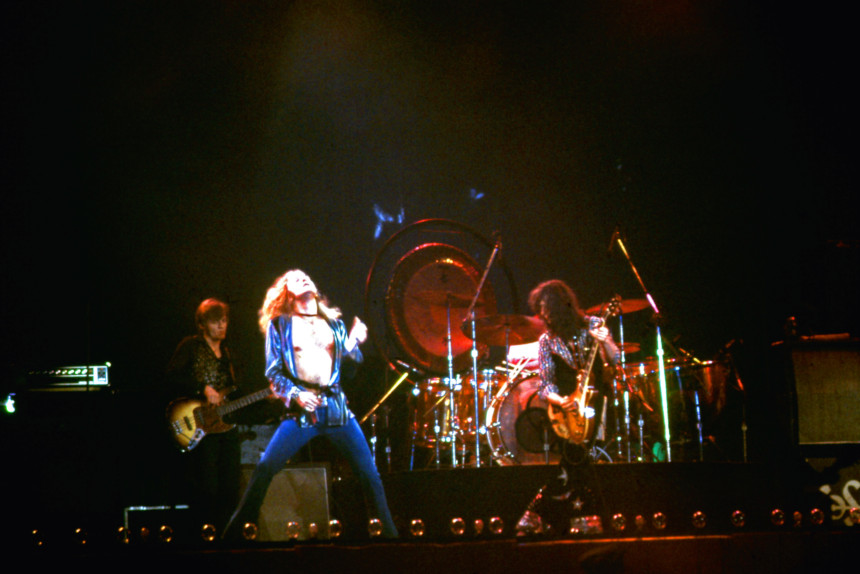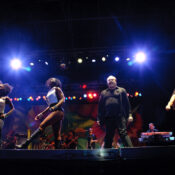Standing at the intersection of blues, early rock and roll, and the origins of heavy metal, four Englishmen became one of the biggest and most enduring bands of all time. The talented singer and virtuosic drummer were barely 20; the multi-instrumentalist bassist and ace guitarist were in-demand studio veterans. Together, they built a sound that infused their influences with raw power and mysticism, crafting a persona and library of music that other bands are still trying to emulate. They were, of course, Led Zeppelin. And 50 years ago this week, they released one of the most legendary albums ever made.
Jimmy Page had been one of the guitar players for The Yardbirds; as that band was dissolving, Page worked to put together a new supergroup-style line-up to both carry on as The New Yardbirds and fulfill previously booked concert obligations. Vocalist Robert Plant of Band of Joy came with strong recommendations, and Plant suggested his long-time friend and Band of Joy drummer John Bonham. Hearing about the group and encouraged by his wife, John Paul Jones asked Page about the bass role, and soon filled it. Page knew that the line-up was a winner, and they played their first show as The New Yardbirds in Denmark on September 7, 1968. The group had to stop using the New Yardbirds name after the dates were fulfilled; legend has it that the new name came from a joke about the new line-up going over like a lead balloon. A word tweak here and a word substitution there, and Led Zeppelin was born. By October 25, 1968, they would be performing under the new name.
“Whole Lotta Love” (Uploaded to YouTube by Led Zeppelin)
In 1969, the band went for the throat of rock in both the U.S. and U.K. The self-titled debut album landed in January with Led Zeppelin II following that October. During the year, they toured the States four times and matched that in England. The first record went Top Ten in the U.S., and II went straight to #1. The group built critical acclaim and an ardent fanbase from their potent brew of blues fundamentals as a foundation for heavy rock. Both albums are packed with songs that have become pillars of rock radio, from “Dazed and Confused,” “Communication Breakdown,” and “Good Times, Bad Times” on the first one to “Whole Lotta Love,” “Heartbreaker,” “Thank You,” and “Ramble On” on the second. Despite the band’s aversion to releasing singles, some songs were marketed that way in the U.S., with “Whole Lotta Love” going to #4.
“Immigrant Song (Live 1972)” (Uploaded to YouTube by Led Zeppelin)
In practice, the band vastly preferred performing live as opposed to making television appearances or following the normal thrum of album-single-tour-single-repeat. They wanted listeners to experience the album as a whole and to experience the band as part of an audience. Zeppelin shows became marathon affairs, with extensive jams and solos added to songs and blues and early rock covers popping up on the set lists. For Led Zeppelin III, the band surprised many with a shift toward a mix of acoustic numbers and rock material. While the unplugged tunes had Celtic folk flair, the harder stuff landed heavily, notably the band’s homage to Vikings and Norse mythology, “Immigrant Song.”
“The Battle of Evermore” (Uploaded to YouTube by Led Zeppelin)
After the release of III, the group decided to take time off from touring and work on their fourth album. The record came together in stages across three countries. After spending time in Wales to write, the group did some recording in London’s Basing Street Studios. They subsequently switched to the Headley Grange house in Hampshire, England. Engineer Andy Johns, known for working with both Zeppelin and The Rolling Stones, took the Rolling Stones Mobile Studio truck to Hampshire for the band’s use. The Stones’s piano player, Ian Stewart, accompanied Johns to lend a hand. The first mix of the record took place in Los Angeles, though Page, who also produced, would remix the whole album before it was released.
“Rock and Roll (Live at Knebworth 1979)” (Uploaded to YouTube by Led Zeppelin)
The Headley Grange environment offered the band a chance to relax and put songs together while jamming and rehearsing. One session with Stewart sitting in on piano yielded what would become a Zeppelin staple, “Rock and Roll;” Stewart played on, and is credited on, the final version for the album. Overall, the album veers from acoustic or mandolin-flavored tracks like “Going to California” and “The Battle of Evermore” to harder stomping numbers like “Black Dog” and the blues cover “When the Levee Breaks.” “Misty Mountain Hop” brought in the propensity for Tolkien references that lyricist Plant indulged on earlier songs like “Ramble On.”
“Stairway to Heaven” (Uploaded to YouTube by Led Zeppelin)
But the centerpiece of the album would be a Plant and Page collaboration that clocked in at just over eight minutes. Page had started working out various guitar parts in the studio in London, while Plant wrote the majority of the lyrics while listening to Page play guitar sections at Headley Grange. Page recorded the final version of the major guitar solo over three takes in the studio back in London. The structure of “Stairway to Heaven” allows each member of the band to shine as it goes through several movements. Between Page’s acoustic guitar work that transitions to the wailing electric solo, Jones’s recorders and additional instrumentation, Bonham’s building percussion, and Plant’s operatics, it’s a piece that builds and builds until it bursts and settles back down to Plant’s final plaintive line reading.
“Black Dog” (Uploaded to YouTube by Led Zeppelin)
It’s almost futile to try to quantify what happened next. The band released the untitled album without the group’s name or logo, their own names replaced by inscrutable symbols of their choosing. (In fact, it’s really only colloquially named Led Zeppelin IV.) Nevertheless, when it was released during this week in 1971, it almost instantly became a keystone document in rock and heavy metal. Hitting #1 in the U.K. and the #3 in the States, the album has gone on to sell a mind-boggling 37 million copies around the world. It’s one of the most popular and most praised records in history. Writing for the Village Voice, Robert Christgau called it “the definitive Led Zeppelin and hence heavy metal album.” While critics and scholars debate the exact moment of the heavy metal genre’s creation, it’s generally agreed that IV influenced essentially everything that came after it. It resides on every major list of the Greatest Albums of All Time, including those by Rolling Stone magazine, NME, and the Rock and Roll Hall of Fame. Tracks from Led Zeppelin IV are played on radio stations every single day to this date. It is a monolithic, inescapable collection of rock music. In a Rolling Stone interview, Foo Fighters leader Dave Grohl succinctly summed up the meaning of the band: “Heavy metal would not exist without Led Zeppelin, and if it did, it would suck,”
The band would continue its incredible run of success until 1980. John Bonham died after a night of heavy drinking, and the band dissolved. Though they’ve reunited for special occasions like 1985’s Live Aid, 1998’s Atlantic Records anniversary, and 2007’s Ahmet Ertegun Tribute Concert at the O2 Arena in London (the latter two with Bonham’s son Jason on drums), the full surviving membership has never recorded or toured as Led Zeppelin. Page and Plant worked together as The Honeydrippers in the ’80s and did some new music for their mostly acoustic special and tour in the ’90s, and Page and Jones played with Foo Fighters at Wembely Stadium in London in 2008, but none of that was ever billed as the band.
Why has this album withstood the test of time? Why is it so influential? The musicianship is incredible across the board. Rarely do you find every member of a band lionized so highly at their particular positions, but experts generally agree on the monstrous talent possessed by each member. You can hear echoes of their playing in bands without number. Perhaps only Keith Richards rivals Page for instantly memorable riffs; there may be no banger of the skins more renowned than the hard-hitting Bonham. And Plant’s voice echoes in one way or another in every rock singer from Ann Wilson and Axl Rose to Chris Cornell and Josh Kiszka of Greta Van Fleet. IV landed in the middle of the Venn diagram of raw power and pure artistry, and that combination arrived with classic status. Fifty years later, critics and scholars still dissect the appeal, and still it makes us wonder.
Featured image: Bruce Alan Bennett / Shutterstock.com
Become a Saturday Evening Post member and enjoy unlimited access. Subscribe now




Comments
Bob Taylor, you seem like the kind of guy that just doesn’t want people to enjoy things. Why even post? To prove you’re better or more refined? Please. You’re right that no one cares. It’s just that they don’t care that you don’t like it.
It makes me wonder, too: why would anyone care?
It’s not that I’m so old I can’t be paroxysmic about music anymore. I can be. I’m still thrilled by an Art Tatum recording I heard the other night which I’d never known existed. This morning, it was hearing a broadcast of Mozart’s Requiem on the radio, along with a fascinating tale of Mozart on his deathbed.
For months, I’ve been looking forward to the Get Back movie.
Recently, I read a reference to the old song, Besame Mucho, which has obsessed the musicological part of my mind ever since.
It’s not so bad. I’ve only grown up.